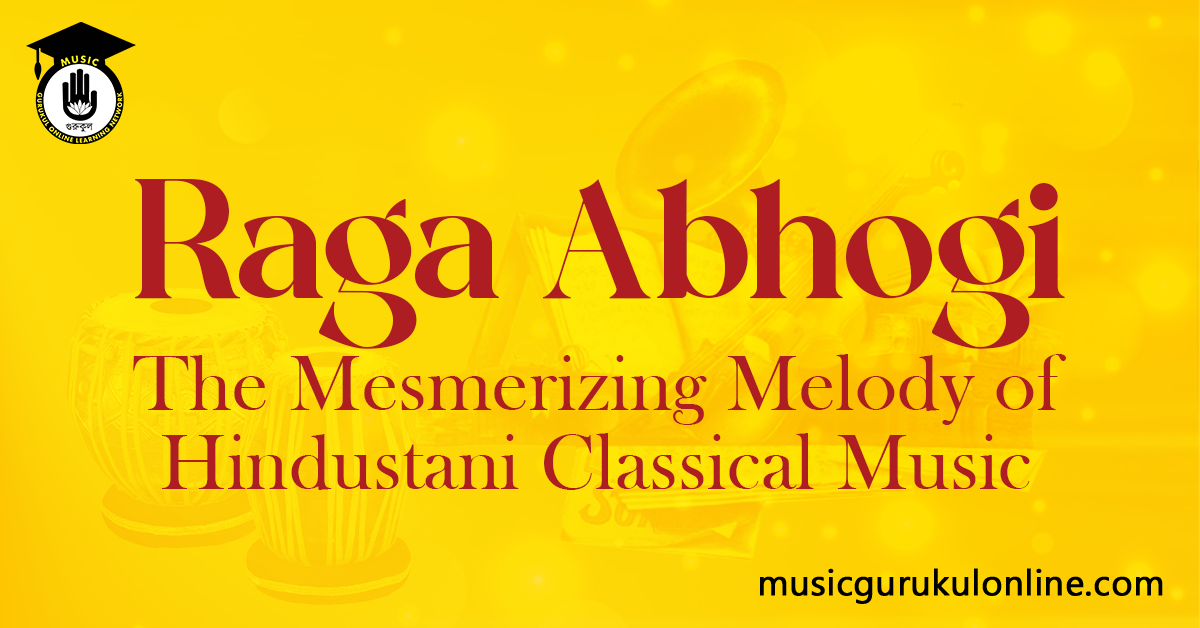Hindustani classical music is a rich and diverse tradition that has evolved over centuries, captivating audiences with its intricate melodies, rhythmic patterns, and emotional depth. One of the most enchanting ragas in this tradition is Raga Abhogi. With its evocative notes and captivating phrases, Raga Abhogi has earned a special place in the hearts of both musicians and music lovers. In this article, we will delve into the characteristics, origins, structure, and emotive appeal of Raga Abhogi, exploring its significance in Hindustani classical music.
Table of Contents
Raga Abhogi

Origins and Historical Significance:
Raga Abhogi is believed to have originated from the Carnatic music tradition of South India. Its roots can be traced back to ancient treatises such as the Natya Shastra, which dates back to the 2nd century BCE. Over time, the raga found its way into the Hindustani classical music repertoire, where it gained prominence and popularity. It is classified as a sampurna (complete) raga, meaning it contains all seven notes of the octave (sa, re, ga, ma, pa, dha, ni) in both ascending and descending order.
Characteristics and Structure:
Raga Abhogi is typically associated with the late-night hours and is categorized under the Bhairavi thaat. It is characterized by a solemn and meditative mood, evoking a sense of introspection and contemplation. The raga is primarily performed in a slow to medium tempo, allowing for the exploration of its nuanced melodic phrases.
The ascending (Aaroha) and descending (Avroha) scales of Raga Abhogi are as follows:
Aaroha: Sa – Re – Ma – Pa – Ni – Sa Avroha: Sa – Ni – Pa – Ma – Re – Sa
The raga does not include the flattened or sharpened notes (komal or tivra) and strictly adheres to the natural notes (shuddha swaras). This simplicity and adherence to the basic notes contribute to the raga’s melodic appeal.
Raga Abhogi also showcases unique melodic patterns called pakad, which define its essence and distinguish it from other ragas. The pakad of Raga Abhogi typically includes the phrases Ma – Re – Ni – Pa and Ni – Re – Sa. These melodic motifs are used as anchor points by musicians to establish the identity of the raga during performances.

Emotive Appeal and Musical Interpretation:
Raga Abhogi’s emotive appeal lies in its ability to evoke a range of emotions and sentiments within the listener. The raga’s contemplative nature creates an atmosphere of introspection and tranquility. The somber and introspective mood of Abhogi makes it an ideal choice for expressing pathos, longing, and introspective states of mind. Its melodic contours and the interplay of notes lend themselves to exploring the subtle nuances of emotions.
Musicians often use the Alap, the initial phase of a Hindustani classical performance, to extensively explore the melodic possibilities of Raga Abhogi. The Alap allows the artist to establish the raga’s mood, explore its various phrases, and build anticipation for the composition to follow.
The composition or bandish in Raga Abhogi is usually set to a specific rhythmic cycle, known as a taal. The choice of taal depends on the artist’s preference, but commonly used taals include Jhaptaal (10 beats) or Ektaal (12 beats). The rhythmic interplay with the melodic framework of the raga adds another layer of depth and complexity to the performance.
Renowned Performances and Impact:
Raga Abhogi has captivated audiences and musicians alike with its unique melodic structure and emotive appeal. Several maestros of Hindustani classical music have left indelible impressions through their renditions of Abhogi. Artists like Pandit Bhimsen Joshi, Ustad Rashid Khan, and Pandit Jasraj have performed mesmerizing renditions of this raga, each infusing it with their distinctive style and creativity.
The popularity of Raga Abhogi extends beyond the realm of Hindustani classical music. It has also found a place in lighter genres such as film music and fusion. Composers in Indian cinema have effectively used Abhogi to create poignant and soul-stirring melodies that resonate with a wide audience.

Raga Abhogi stands as a testament to the beauty and versatility of Hindustani classical music. Its simplicity, yet profound emotional impact, has made it a favorite among artists and listeners alike. Whether performed in a traditional classical setting or adapted to contemporary genres, the raga continues to enchant and move audiences with its evocative melodies. As one delves into the depths of Raga Abhogi, it becomes apparent why it holds a special place in the hearts of those who appreciate the power and beauty of Indian classical music.
See more:
